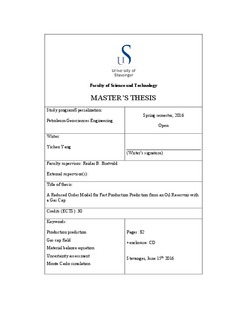| dc.contributor.author | Yang, Yichen | |
| dc.date.accessioned | 2016-10-12T14:56:54Z | |
| dc.date.available | 2016-10-12T14:56:54Z | |
| dc.date.issued | 2016-06-15 | |
| dc.identifier.uri | http://hdl.handle.net/11250/2414801 | |
| dc.description | Master's thesis in Petroleum geosciences engineering | nb_NO |
| dc.description.abstract | Economic evaluations are essential inputs for oil and gas field development decisions. These evaluations are critically dependent on the unbiased assessment of uncertainty in the future oil and gas production from wells. However, many production prediction techniques come at significant computational costs as they often require a very large number of highly detailed grid based reservoir simulations.
In this study, we present an alternative compelling and efficient approach to assess the impact of reserves uncertainty on the oil and gas production from an oil reservoir with a gas cap. The justification for using the reduced order (less detailed) model to assess possible future production is that, for many decisions, it is more important to capture the uncertainties in the production than the production impact of the detailed characteristics of the reservoir in question. The computational costs of the reduced order model presented in this work is small relative to a typical grid based simulator which makes it possible to assess production uncertainties by using Monte Carlo simulation with a large number of iterations.
The model developed in this work combines the use of inflow performance relationship (IPR), tubing performance relationship (TPR) curves with the material balance equation. By balancing the dynamic material balance equation at each time period, the reservoir average pressure decline curve and the oil and gas production profiles can be obtained. The impact of reserves uncertainty on oil and gas production can be assessed by combing this approach with the Monte Carlo simulation method.
We apply the approach to a gas cap field to investigate the impact of reserves uncertainty on oil and gas production. The result shows that the relationship between oil in place, gas cap-to-oil volume ratio and oil production can be expressed in a functional form. One conclusion from this study is that the oil in place uncertainty has a larger impact on oil production than the gas in place uncertainty.
The approach in this study is developed in MATLAB and easy to modify and extend, so it can be applied to other gas cap fields and combined with cash flow model to help the decision maker design specific development and production plans and maximize the overall value of the field. | nb_NO |
| dc.language.iso | eng | nb_NO |
| dc.publisher | University of Stavanger, Norway | nb_NO |
| dc.relation.ispartofseries | Masteroppgave/UIS-TN-IPT/2016; | |
| dc.subject | Monte Carlo simulation | nb_NO |
| dc.subject | petroleum engineering | nb_NO |
| dc.subject | petroleumsteknologi | nb_NO |
| dc.subject | production prediction | nb_NO |
| dc.subject | gas cap field | nb_NO |
| dc.subject | material balance equation | nb_NO |
| dc.subject | uncertainty assessment | nb_NO |
| dc.subject | petroleumsgeologi | |
| dc.subject | petroleum geosciences engineering | |
| dc.title | A Reduced Order Model for Fast Production Prediction from an Oil Reservoir with a Gas Cap | nb_NO |
| dc.type | Master thesis | nb_NO |
| dc.subject.nsi | VDP::Technology: 500::Rock and petroleum disciplines: 510::Geological engineering: 513 | nb_NO |
